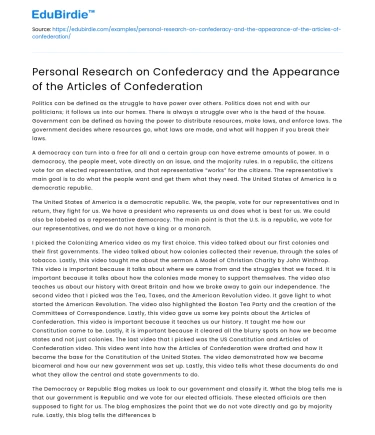Introduction
The formation and evolution of political entities have always been pivotal in shaping the course of history. The Confederacy and the Articles of Confederation represent two significant periods in American history, each illustrating a distinct approach to governance and unity. The Confederacy, a coalition of Southern states during the American Civil War, sought to uphold a decentralized structure and preserve their way of life. In contrast, the Articles of Confederation were the United States' first attempt at a national government post-independence, advocating for sovereignty among states while striving for national cohesion. This essay delves into these two historical constructs, examining their origins, implications, and the lessons they offer in understanding federalism and unity. By analyzing specific examples and scholarly perspectives, this piece aims to illuminate the complexities and challenges inherent in these formative periods of American governance.
The Confederacy: A Quest for Autonomy
The Confederate States of America, commonly referred to as the Confederacy, was established in 1861 by Southern states that seceded from the Union, catalyzing the American Civil War. This coalition was driven by a quest for autonomy, largely motivated by the preservation of states' rights and the institution of slavery. Historian James McPherson notes, "The Confederacy was born of a perceived need to defend a way of life." The Confederacy's constitution reflected these priorities, emphasizing limited central authority and granting significant powers to individual states. For instance, Article I of the Confederate Constitution explicitly restricted the central government's ability to levy tariffs, aligning with the Southern states' economic interests.
Save your time!
We can take care of your essay
- Proper editing and formatting
- Free revision, title page, and bibliography
- Flexible prices and money-back guarantee
The Confederacy's commitment to decentralization, however, proved to be both a strength and a weakness. While it fostered a strong sense of identity and regional loyalty, it also hampered the ability to coordinate resources and strategies effectively during the war. This decentralized approach led to logistical challenges, as evidenced by the difficulty in sustaining supplies and manpower for the Confederate army. The lack of a strong central government hindered the Confederacy's ability to respond to the Union's industrial and military advantages. Ultimately, the Confederacy's insistence on autonomy and limited federal oversight contributed to its downfall by 1865.
Moreover, the Confederacy's emphasis on states' rights as a justification for secession and war presents a critical counter-argument. Scholars like Drew Gilpin Faust argue that the Confederacy's failure to reconcile its desire for autonomy with the necessity of collective action highlights the inherent contradictions in its political ideology. This analysis underscores the complexities of balancing local autonomy with national unity, a theme that resonates in contemporary discussions of federalism.
The Articles of Confederation: An Experiment in Unity
The Articles of Confederation, ratified in 1781, represented the United States' first attempt at a unified national government following the Revolutionary War. This document aimed to balance the sovereignty of individual states with the need for a cohesive national policy. As noted by historian Gordon S. Wood, "The Articles were a reflection of the revolutionary generation's fear of centralized power." Consequently, the Articles granted the national government limited authority, with significant powers retained by the states.
One of the key features of the Articles was the establishment of a unicameral legislature, where each state had equal representation regardless of size or population. This structure was intended to protect the interests of smaller states and prevent the dominance of larger ones. However, the lack of a strong executive branch and the inability to levy taxes or regulate commerce severely limited the federal government's effectiveness. Real-life challenges, such as the inability to raise funds for national defense or manage interstate disputes, exposed the weaknesses of the Articles.
Despite these limitations, the Articles of Confederation provided valuable lessons in governance. They highlighted the importance of balancing state and federal powers, a principle that influenced the drafting of the U.S. Constitution. The shortcomings of the Articles prompted calls for a stronger national government, ultimately leading to the Constitutional Convention of 1787. This transition marked a pivotal moment in American history, as the nation moved towards a more centralized federal system capable of addressing the challenges of a growing republic.
Conclusion
The examination of the Confederacy and the Articles of Confederation reveals the complexities and challenges of governance in the face of competing interests and ideologies. While the Confederacy's emphasis on autonomy and states' rights ultimately contributed to its downfall, it also offered insights into the importance of balancing local and national priorities. Similarly, the Articles of Confederation, despite their limitations, provided a foundation for understanding the need for a strong yet flexible federal system. Both historical constructs underscore the delicate interplay between autonomy and unity, a theme that continues to be relevant in contemporary political discourse.
By analyzing these historical examples, we gain a deeper understanding of the principles and challenges of federalism. The lessons learned from the Confederacy and the Articles of Confederation continue to inform debates on governance, sovereignty, and the balance of power within a nation. As we reflect on these formative periods, we are reminded of the enduring struggle to reconcile individual and collective interests in the pursuit of a cohesive and functional society.






 Stuck on your essay?
Stuck on your essay?

